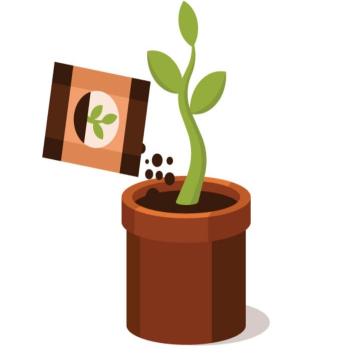Importance of Fertilization
Fertilization is crucial for maintaining healthy plants in your home garden. It provides essential nutrients that plants need but may not get from the soil alone. Understanding the basics of fertilization can help you achieve optimal growth and yield.
The Basic Nutrients: NPK
NPK refers to the three primary nutrients essential for plant growth:
- Nitrogen (N): Promotes leafy, green growth and overall vigor.
- Phosphorus (P): Supports root development, flowering, and fruiting.
- Potassium (K): Aids in disease resistance, overall plant strength, and fruit quality.
Understanding Nutrient Levels
On fertilizer labels, you'll see three numbers (e.g., 10-5-5). These indicate the percentage by weight of N, P, and K in the fertilizer. Higher numbers mean a higher concentration of that nutrient.
Micronutrients and Their Benefits
In addition to NPK, plants require small amounts of micronutrients like:
- Iron (Fe): Important for chlorophyll production and overall plant health.
- Manganese (Mn): Essential for photosynthesis, nitrogen assimilation, and enzyme activation.
- Zinc (Zn): Necessary for enzyme function, protein synthesis, and regulation of plant growth hormones.
- Copper (Cu): Aids in photosynthesis, enzyme activation, and carbohydrate metabolism.
- Molybdenum (Mo): Required for nitrogen fixation and the conversion of nitrates into amino acids within plants.
- Boron (B): Critical for cell wall formation, pollen tube growth, and carbohydrate transport.
- Chlorine (Cl): Involved in osmotic regulation and photosynthesis, though needed in very small amounts.
- Nickel (Ni): Facilitates nitrogen metabolism, particularly in leguminous plants.
Micronutrients prevent deficiencies that can lead to stunted growth, yellowing leaves, or poor fruit production.
Nutrient Requirements for Different Plant Categories
Different plants have varied nutrient needs:
- Vegetables: Often require balanced NPK ratios, with higher nitrogen early on for foliage and balanced phosphorus and potassium for fruiting.
- Flowering Plants: Benefit from higher phosphorus to promote blooms and root development.
- Fruit Trees: Need potassium for strong fruit development and disease resistance.
Organic vs. Non-Organic Fertilizers
Organic Fertilizers:
- Pros: Improve soil structure, provide slow-release nutrients, and enhance microbial activity.
- Cons: Nutrient levels may vary, slower initial nutrient availability.
Non-Organic Fertilizers:
- Pros: Provide precise nutrient ratios, immediate availability, and higher concentrations.
- Cons: Can harm beneficial soil organisms with overuse, may lead to nutrient leaching.
Best Time to Add Fertilizer
- Spring: Apply before planting to boost early growth.
- Summer: Feed actively growing plants to sustain growth.
- Fall: Prepare plants for winter and encourage root development.
Application Tips
- Even Distribution: Scatter evenly around the plant's drip line.
- Watering: Water after application to help nutrients reach the roots.
- Avoid Over-Fertilizing: Excess can harm plants and leach into groundwater.
Conclusion
Effective garden fertilization involves understanding nutrient needs, choosing the right type of fertilizer, and timing applications correctly. By meeting your plants' nutritional requirements, you can ensure robust growth, vibrant blooms, and healthy yields in your home garden.

